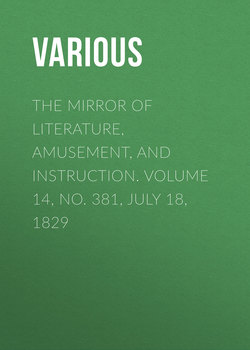The Mirror of Literature, Amusement, and Instruction. Volume 14, No. 381, July 18, 1829

Реклама. ООО «ЛитРес», ИНН: 7719571260.
Оглавление
Various. The Mirror of Literature, Amusement, and Instruction. Volume 14, No. 381, July 18, 1829
THE MANSION OF HIS GRACE THE DUKE OF WELLINGTON
WATLING STREET
THE PENDRILLS
THE FRIENDS OF THE DEAD
The Cosmopolite
FOOD OF VARIOUS NATIONS
Manners & Customs of all Nations
SINGULAR TENURE
BOROUGH-ENGLISH
STORM RAISING
NEAPOLITAN SUPERSTITION
The Naturalist
LENGTH AND FINENESS OF THE SILKWORM'S WEB, &c
CUCKOO
MUSICAL SNAILS
BEWICK
The Argonaut, Or Paper Nautilus
THE SELECTOR; AND LITERARY NOTICES OF NEW WORKS
VIDOCQ
SPIRIT OF THE PUBLIC JOURNALS
THE TOYMAN IS ABROAD
Notes of a Reader
THE LAST OF THE PLANTAGENETS
ANTIQUITIES BURLESQUED
MOCHA
ENGLISH AND FOREIGN NEWSPAPERS
The Gatherer
REFLECTION IN A FLOWER GARDEN
A "THIN NIGHT" AT VAUXHALL
NAPOLEON BONAPARTE AND LORD NOEL BYRON
Отрывок из книги
The town mansions of our nobility are generally beneath all architectural criticism; and it has been pertinently observed that "an educated foreigner is quite astonished when shown the residences of our higher nobility and gentry in the British capital. He has heard speak of some great nobleman, with a revenue equal to that of a principality. He feels a curiosity to look at his palace, and he is shown a plain, common, brick house of forty or fifty feet in extent." These observations were made about three years ago, since which period, the spirit of architectural improvement has been fast extending from public buildings to individual mansions. Among the latter, the renovation or encasement of Apsley House, at Hyde Park Corner, with a fine stone front, is entitled to foremost notice.
This splendid improvement is from the designs of Benjamin Wyatt, Esq. and is of the Palladian style. The basement story is rusticated, and the principal front has a handsome pediment supported by four columns of the Corinthian order. A bold cornice extends on all sides, which are decorated at the angles with Corinthian pilasters. The whole has an air of substantial elegance, and is in extremely good taste, if we except the door and window cases, which we are disposed to think rather too small. The Piccadilly front is enclosed with a rich bronzed palisade between leaved pillars, being in continuation of the classical taste of the entrance gates to Hyde Park, and the superb entrance to the Royal Gardens on the opposite side of the road. Throughout the whole, the chaste Grecian honey-suckle is introduced with very pleasing effect.
.....
Hoveden thinks it was called the Watling Street from Wathe, or Wathla, a British king. Spelman fancies it was called Werlam Street, from its passing through Verulam. Somner derives the name from the Belgic Wentelen, volvere, versare se, a sinuosis flexibus. Baxter contends that it was made by the original Britons, Weteling, or Oedeling signifying in their language, originarius civis vel ingenuus. Stukeley's opinion, in which he is joined by Whitaker, the Manchester historian, is, that it was the Guetheling road—Sarn Guethelin, or the road of the Irish, the G being pronounced as a W. Dr. Wilkes says, that it is more indented and crooked than other Roman Roads usually are, and supposes that it was formed of Wattles, which was the idea also of Pointer. Mr. Duff is not pleased with the opinion of Camden, that it derives its name from an unknown Vitellianus, but conjectures that its etymology is from the Saxon Wadla, a poor man, a beggar, because such people resorted to this road for the charity of travellers.
The same author, in his Life of Vitellius, seems to strengthen or rather establish the conjecture of its being the Vitellii Strata Via, for he says, (chapter 1,) "indicia, stirpis (Vitelliorum) diu mansisse, Viam Vitelliam ab Janiculo ad mare usque, item coloniam ejusdem nominis." Or, "Some monuments of the family continued a long time, as the Vitellian Way, reaching from the Janiculum to the sea, and likewise a colony of that name." From the abovementioned extracts, it seems not improbable that one of the thirty battles mentioned by Suetonius, might have been fought during the time the Romans were forming this road through the Forest of Arden, which extended from Henley, in Warwickshire, to Market Harborough, in Leicestershire; and that it was called in compliment to Vitellius, the Vitellian Way, afterwards corrupted to the Watling Way.
.....